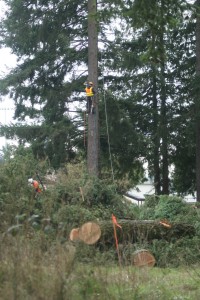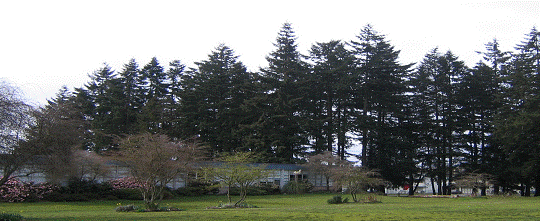The Seattle Department of Planning and Development (DPD) is continuing a rigged phony public involvement process in seeking comment on its proposed plan to deregulate tree protection in Seattle. DPD’s posting of a “Summary of Comments Received on DPD Tree Regulations” does little if anything to clarify the issues involved in trying to protect trees in Seattle or help in drafting real urban forestry and tree protection legislation.
The problem starts with the fact that the very people who produced the summary are opposed to tree regulations and proposed to deregulate all tree protection for the City in their draft document. They ignored the Seattle City Council’s resolution #31138 urging development of a proposal to increase tree protection and chose to propose the opposite by wiping out the existing protections for mature trees and tree groves and proposing instead to “provide incentives and educate people to save trees”. They cited no examples of where this has worked elsewhere.
Now, rather than publishing the actual letters and comments of those that gave input on their proposal, like other cities have done (eg see Shoreline’s public comments on their tree protection proposal here) , DPD choose instead to anonymously publish what seems to be their edited “notes” of so called public meeting comments and and written comments.
At least two separate DPD personnel were probably involved in this so called summation. Without any written record being presented we are expected to accept DPD’s version of feedback made in some instances by “numerous commenters”, while other comments are attributed to a single person or a group. A summation is fine if one can refer to the original comments but all that is available on the Internet by DPD is their version of what was said. Unfortunately many comments are missing fronm their summation or were edited by DPD.
Having attended 7 of these community sessions, I noted that no audio or video recording was made at any of these meetings, no one was visibly taking notes most of the time and response forms were maybe present once or twice but otherwise no record seemed to be kept of individual meetings or comments. The summary is not attributed to any author or staff person but was probably done by DPD staffer Brennon Staley since he did many of the meetings mentioned.
At the Save the Trees meeting, e.g. to which Brennon Staley was invited, we spent an hour discussing issues. We presented a written 10 point plan on what we felt should be in a good urban forestry protection law. When asked how he was recording our discussion he indicated he was taking “notes”, although I saw little note taking.
So in the DPD summary a specific written comment from our handout like “Consolidate oversight, regulation and enforcement in an independent department other than DPD, that does not have a conflict of interest.” became “Consider consolidating all regulations, permits and staff dealing with trees into a single Department.” This is the type of editorial revision that takes place in the summary. Other specific comments like”2 week posting of permits on the Internet and visible sign on the site” are likewise abbreviated and reworded.
A comment supposedly attributed to me (my name is misspelled) says “Requirements shouldn’t be based on development potential; they should be based on the existing conditions on a lot” is not how I would have expressed this idea. My comment related to requiring consideration of building within the existing environment, rather than ignoring it, which is what currently policy seems to do.
Another comment also attributed to Save the Trees says, “Lots without trees could have their property tax increased.” This is not a Save the Trees position and to attribute a comment supposedly made by an individual in a discussion as from Save the Trees is a misuse and misrepresentation of the organization’s name and position.
We submitted an official statement to DPD as to our position and I think it is unprofessional and unethical to ignore those comments and instead allow one or two staff members from DPD to interpret and put in their own words what “the public said”.
This is all the continuation of a biased process, driven by interests within DPD that want to deregulate tree protection and have basically done so in their permitting process based on their history. DPD is trying to put in law what they have been doing for years, basically saying they are all for protecting trees “unless it limits the development potential of a lot.”
As neighbors learned in the Ingraham appeal process, DPD instructs its people not to put their policy considerations used to arrive at a decision in writing, so that they cannot be required to be produced and challenged in Court.
The same thing has happened in the development of the proposed DPD tree regulations. Internally, the urban forest contingent from the different City Departments has been told not to keep notes of any of their discussions and deliberations. While taxpayers pay their salaries, we are not allowed access to their deliberations. There are no notes kept of meetings according to those we have talked to.
So the summary follows a similar process and DPD seemingly thinks this is acceptable and normal procedure for a public process. Don’t publish what people actually wrote or record what they said but “summarize” it and interpret it and emphasize what you want and ignore what you don’t want. It becomes a very subjective evaluation based on the summarizer’s memory and focus and DPD’s politics and bias.
This is an attempt to control the dialogue and information flow and discussion. In politics this is called spin. Rather than let the public see the actual comments as written or hear them on an audio or video recording like the City Council does, DPD states that “numerous commenter’s” said such and such and equates many comments as numerous. But what is numerous. Anything more than 1 person, 2, 5 or 10 or more than one group? What did they actually say?
The whole process was actually not a very public process besides the Sept. open house, since no other meetings were publicly announced or posted on the City’s website. Although DPD speakers were being paid with tax dollars to basically promote DPD’s tree deregulation proposal, Brennon Staley refused several public requests from me to say where they were speaking.
He said he did not have to tell us.He stated this in two separate public meetings. He refused to post any of these taxpayer paid speaking engagements on the website for public outreach. Without any basis, he insinuated that “we would come and disrupt” the meetings.
And efforts by us and others to get public input in, when they were excluding public participation at meetings they were speaking at, are labeled as “Organized participation (including letter writing campaigns) by advocacy groups predominantly supported stronger tree protections.” The allusion is that this is not good. I did not know this was something bad, to ask people to respond, when DPD was doing little to invite public involvement or comment. Would this same comment have been made if we were urging people to say we liked DPD’s proposal?
All in all, I think DPD’s summary of comments is of limited value except to say there is a diversity of viewpoints out there. DPD has used the summation process to selectively pick certain comments to print, to put their interpretation on them by paraphrasing as best they can remember them without any recording and to exclude other comments. The summary presents a smattering of ideas but equates many as equal by calling them all either numerous or only citing one commenter making it. It’s all political spin by DPD to control the process rather than open the process up for public dialogue.
All in all, DPD is trying to create the illusion of public input, while tightly trying to limit and spin to their advantage what the public said. Without recorded comments or producing the written record, we only have DPD’s version of events. And that is not very credible.
Steve Zemke
Chair Save the Trees-Seattle







